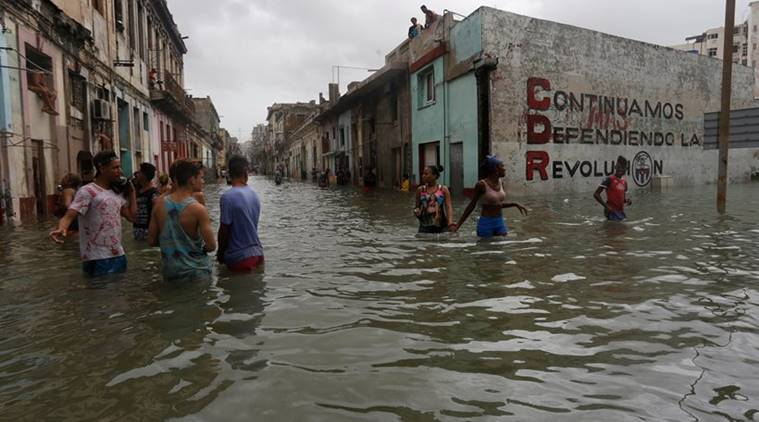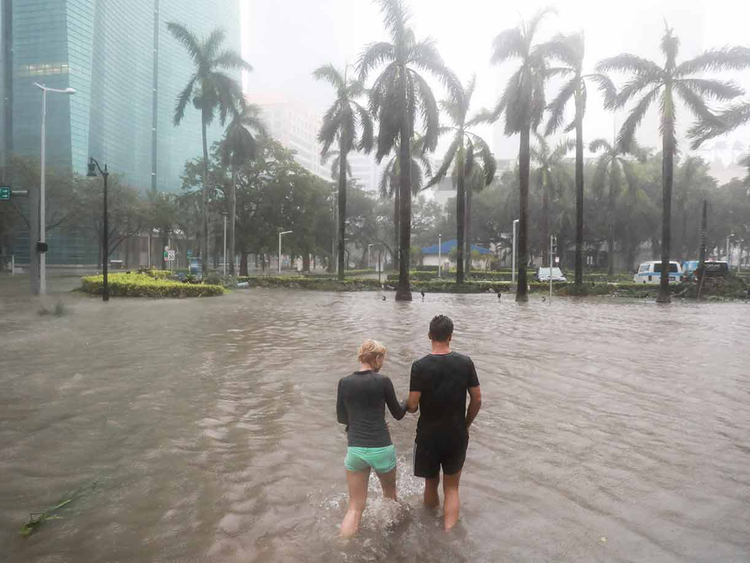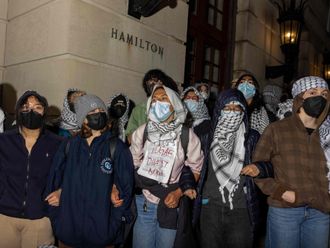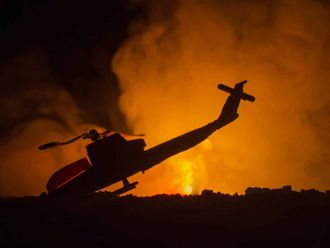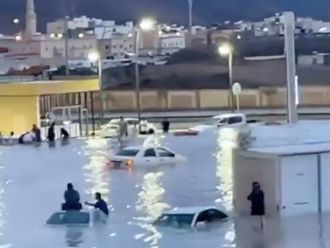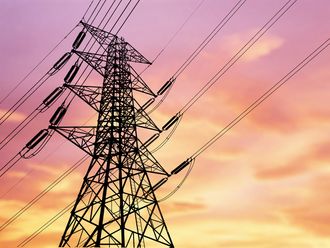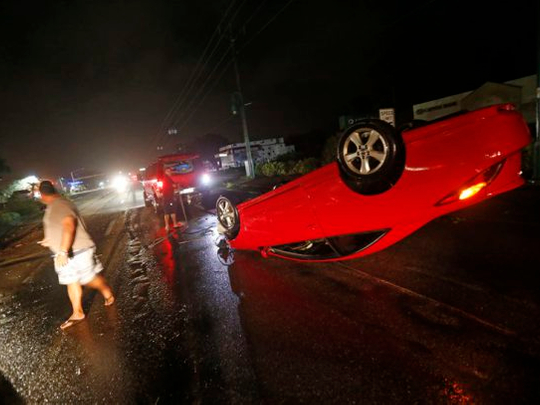
Up to 5.7 million people are without power after Hurricane Irma, said to be one of the fiercest Atlantic storms in a century, hammered Florida on Sunday and overnight on Monday, setting off one of the largest evacuations of Americans from a storm. These are the latest upates (all times Dubai):
4.12pm
Millions of people in Florida are waking up without power Monday as Hurricane Irma rumbles north, spurring slashing gusts of wind, pounding rain and perilous storm surge.
As dawn approached, emergency responders implored citizens to stay in place and not to venture outside until crews can assess damage and give the all-clear that it's safe to leave their homes.
The storm left more than 5.7 million customers without power and littered the state with downed trees, downed power lines and standing water.
Emergency crews made rescues throughout the night. The storm is plowing into Georgia and others parts of the Deep South — Alabama, Tennessee and the Carolinas — bringing the danger of life-threatening storm surge and hazardous winds.
According to the National Hurricane Center's 5 am advisory (1pm in Dubai), Irma was downgraded to a Category 1 storm, still a monster despite the weakening. With sustained winds of 75 mph and its center 60 miles north of Tampa, Irma is moving across the northern half of Florida's peninsula.
3.35pm
Hurricane Irma knocked out power to a million homes and businesses in Florida, threatening millions more as it crept up the state’s west coast, and full restoration of service could take weeks, Reuters quoted local electric utilities as saying.
Irma hit Florida on Sunday morning as a dangerous Category 4 storm, the second highest level on the five-step Saffir-Simpson scale, but by afternoon as it barreled up the west coast, it weakened to a Category 2 with maximum sustained winds of 110 miles per hour (177 kph).
According to the National Hurricane Centre, the wind gusts near hurricane force began to batter the Florida Keys late night on Saturday.
Cuba has already been devastated by Irma and has killed at least 25 people in the Caribbean.
Hurricane floods leave Cubans waist-deep in water https://t.co/YONh3zRZ5z by @Alexgrosbois 📷 Yamil Lage #AFP pic.twitter.com/0xI20YZQig
— AFP Photo (@AFPphoto) September 11, 2017
According to the National Hurricane Centre, Category 5 is the strongest intensity of a storm. Irma said to be the first-ever storm to sustain winds of 185 miles per hour for longer than 24 hours in the open Atlantic Ocean can be devastating if it makes landfall.
2.50pm
Flash Flood Emergency for downtown Jacksonville issued by Jacksonville WFO due to hurricane Irma.
2.45pm
The National Weather Service in Jacksonville issued a Flash Flood warning for Cental Duval County in northeastern Florida until 12.45 pm EDT, Monday. Areas near the St Johns River are under the threat of flash floods as the water is expected to rise another 1 to 2 ft when winds switch and push water northward and the high tide begins to come into river.
The people have been warned to not wade through the flood waters as they can be swept away in swiftly rising water. They have been further advised to move to higher ground as the situation remains life-threatening.
12.02pm
Hurricane Irma took aim at heavily populated areas of central Florida on Monday as it carved a path of destruction through the state with high winds and storm surges that left millions without power, ripped roofs off homes and flooded city streets.
Irma, once ranked as one of the most powerful hurricanes recorded in the Atlantic, came ashore on Florida on Sunday and battered towns up and down the state.
It weakened to a Category 1 hurricane, carrying maximum sustained winds of about 85 miles per hour (135 km per hour) by 2am ET (10am UAE time) on Monday. The storm was churning northwest in the center of the state near the Tampa and Orlando metro areas on Monday morning, the National Hurricane Center said.
6.53am
MIAMI: Hurricane Irma lashed the Florida mainland on Sunday, where anxious residents prepared to be "punched in the face" by the monster storm after it whipped the Keys island chain with fearsome wind gusts.
Six million people have been ordered to flee the path of the hurricane, which weakened to a Category Two storm as it churned past the Keys, but was still packing dangerous winds of up to 110 miles (177 kilometers) per hour.
Handfuls of holdout residents, having defied calls to evacuate, hunkered down as Irma tore over the Keys, ripping boats from their moorings, flattening palm trees and downing power lines across the island chain popular for fishing and scuba diving.
"There's absolutely no way anybody can be outside right now," Maggy Howes, a first responder on Key Haven, told CNN. "You would not be able to stand or walk."
Hours later, the storm made a second landfall on Marco Island near the beach resort of Naples, unleashing high winds and rain across southern Florida and cutting power to two million people as it moved up the western Gulf coast.
One of the mightiest hurricanes ever to slam the state, Irma is threatening dangerous storm surges of up to 15 feet (4.5 meters), enough to cover a house, as it collides with Florida after sowing devastation through the Caribbean.
"I am concerned about people that don't believe in the storm surge," said Virginia Defreeuw, 76, who fled her mobile home in Naples to a shelter. "You need to be afraid of the storm surge! People are not listening."
In Miami, the storm brought at least two construction cranes crashing down, while the glitzy Brickell neighborhood was flooded by waters "coming over the sea walls," according to Steven Schlacknam, a 51-year-old visual artist watching from a 37th floor apartment.
Tampa Mayor Bob Buckhorn was blunt about the threat to the low-lying and densely populated Tampa Bay peninsula: "We are about to get punched in the face by this storm."
'Lives, not cost'
President Donald Trump, who vowed to travel to Florida "very soon," approved the state's request for emergency federal aid to help with temporary housing, home repairs, emergency work and hazard mitigation.
"Right now, we're worried about lives, not cost," Trump said.
At least 30 deaths are already attributable to the storm, including three in Florida. The US victims included a sheriff's deputy killed in a head-on collision early Sunday as she drove home for supplies after working in a shelter all night.
Irma smacked the Keys 57 years to the day that Hurricane Donna hit the same area in 1960, destroying nearly 75 percent of the island chain's buildings.
A shelter of last resort set up in the Middle Keys city of Marathon was reported to be without power or running water, and surrounded by surging waters.
Irma also led to some uniquely Floridian responses, with a sheriff forced to warn residents not to shoot at the storm after an online prank promoting the idea went viral.
"To clarify, DO NOT shoot weapons @ #Irma," the office of the sheriff of Pasco County, on the state's west coast, tweeted hours before landfall.
Miami spared worst
In Miami, where emergency services were sheltering in place, a dispatcher talked a woman through delivering her own baby on Sunday morning, Assistant Fire Chief Eloy Garcia told the Miami Herald.
At least two towering construction cranes had collapsed downtown, according to residents who chose to ride out the storm rather than heed calls to evacuate.
But Miami Beach, a resort island normally buzzing with tourists, had prepared for an apocalyptic event - and residents reached by AFP were grateful they had been spared the worst.
"It's a show but not a catastrophic event," said Roberto Cuneo, a 41-year-old realtor who had decided not to flee.
State-wide, nearly two million homes and businesses lost power, according to utility company Florida Power and Light, which said it had "safely shut down" one of two nuclear reactors at its Turkey Point power plant.
Before reaching the United States, Irma smashed through a string of Caribbean islands from tiny Barbuda on Wednesday, to the tropical paradises of Saint Barthelemy and Saint Martin, the US Virgin Islands, Puerto Rico, the Dominican Republic, Haiti and the Turks and Caicos.
Terrified Cubans who rode out Irma in coastal towns - after it made landfall Friday on the Camaguey archipelago as a maximum-strength Category Five storm - reported "deafening" winds, uprooted trees and power lines, and blown rooftops.
There were no immediate reports of casualties in Cuba but it caused significant damage, and enormous waves lashed the Malecon, Havana's emblematic seafront, with seawaters penetrating deep into the capital.
Storm surge, tornado risk
Irma is so wide that authorities faced destructive storm surges on both coasts of Florida and the Keys as Irma follows a path north toward Georgia.
The NHC also warned of tornado risks through Sunday night, with the greatest threat in areas east of the storm's path.
Businesses on both Florida coasts were shuttered.
MacDill Air Force Base in Tampa, the military installation home to US Central Command, issued mandatory evacuation orders ahead of the storm's passage early Monday, while the Kennedy Space Center on the east coast was also closed.


